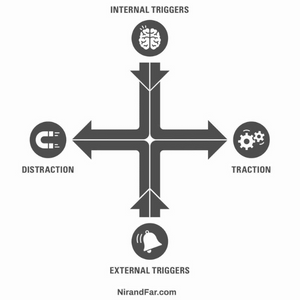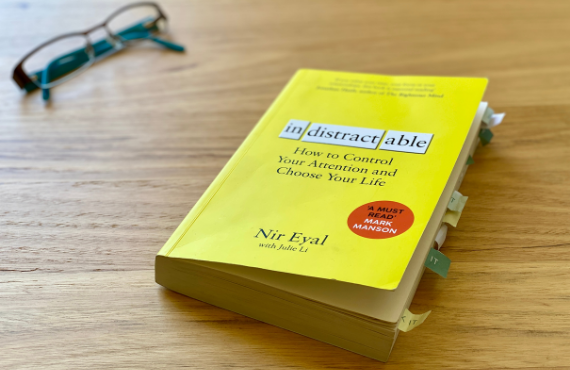Nir Eyal’s Indistractable: How to Control Your Attention and Choose Your Life is an accessible, action-focused read for anyone who wants to spend their time more intentionally, without giving up their tech.

Unlike many books on focus, this is clearly written by someone who loves technology. Nir looks at the science behind why we are drawn to distraction, and practical approaches to “hack back” the triggers that aren’t serving us. It’s a refreshing perspective, taking readers beyond blaming technology for their frustrations, working with it to address something deeper.
Indistractable’s unique scope also reaches beyond the reader to others in our lives. Nir dedicates seven chapters to impacts and solutions to distraction in children, friends and family members.
The Indistractable Model
The core premise of the book is that we experience a range of triggers that are either internal (e.g. feeling of boredom) or external (e.g. a notification) or). These triggers can drive us to do something meaningful and intentional: traction. Or we can be drawn to something else: distraction.
Let’s put it to action.
I. Master internal triggers
Nir explains that when we experience some form of discomfort – fatigue, boredom, frustration, overwhelm… – we try to relieve it by switching focus. We stare into the fridge, check our news feed, delete some emails.
These alternative activities can feel productive. You do need to each lunch sometime, and you may find satisfaction at inbox zero. The key is drawing attention to this process to understand what really triggered us to switch focus.
When you find yourself turning away from your intended task, Nir suggests:
- Look for the emotion preceding the distraction, write it down, and explore it with curiosity instead of contempt
- Be particularly wary during liminal moments: transitions between activities
- Surf the urge: try resisting for 10 minutes to test whether it should be acted on
- Try reimagining a dreary task to make it fun, novel or deliberately attention-holding
- Reimagine your own capacity for focus. Those who believe their willpower is finite are less likely to achieve their goals.
MY ACTION:
Liminal moments were a pitfall for me. Whenever I transitioned to a kid-free moment, I'd instinctively pull out my phone as a reprieve from the screen-free interactions I've (hopefully) had with them. Setting time limits on key apps allowed me to see just how much time those quick checks were adding to, and reflect on if/when it was justified. I'd then reimagine those times as brain breaks, to take a few breaths and clear my head.
2. Make time for traction
Consistent with the TimeBeings approach, Indistractable recommends you explore your values across different life domains (you, relationships and work) to consider their alignment with your time choices. Then decide on how much time you’d like to spend on activities in each domain per week to live out the life you aspire to.
“In order to live our values in each of these domains, we must reserve time in our schedules to do so. Without planning ahead, it’s impossible to tell the difference between traction and distraction.”
Nir recommends absolute timeboxing: eliminating white space in your calendar, so that you’re clear on your intent for your time. He contends that success be judged by whether you executed on those intentions (which interestingly contrasts with Cal Newport’s emphasis in Deep Work). With each week viewed as a mini-experiment, Nir suggests end-of-week reviews of how you executed your intentions and what changes could be made to better align your values and time.
While less applicable to my personal situation, I loved reading Nir’s chapter on synching (or discussing time expectations) with colleagues at work, which can actually help you work async. I have certainly observed workplaces where poor expectation management has led to group time norms that compromise work/life balance. Open conversations about expected response times, availability and opportunities for flexible working hours can be seriously empowering.
MY ACTION:
I timebox my work sessions (if they're longer than 1.5 hours) because I know I need to be proactive with planning my breaks to avoid distraction. When I feel the urge to check my phone or read an off-topic article, I often find it's time for a break. Scheduling what my break will involve (a walk, phone call, snack) helps me execute on something restorative.
I've found absolute timeboxing too restrictive outside the work domain, where I'd like to be responsive to others' needs and wants. I aim to chat with my family in advance about what they'd like to do with their/our time so I can be sure everyone's needs are met.
Lone leisure time is my greatest opportunity for distraction. My best strategy has been to leave a good book on the couch to remind me that I have good options available.
3. Hack back at external triggers
If you’re looking for act-as-you-read-it advice, this comprehensive section will not disappoint. Separately addressing work interruptions, email, group chat, meetings, your smartphone, your desktop, online articles and feeds, Nir offers practical solutions to help tech-lovers operate more intentionally. Some of my favourite quick wins:
- Interruptions: Physical signals of deep work blocks to ensure those in your space don’t disturb your focus (I loved his wife’s concentration crown!).
- Email: Office hours for non-urgent enquiries – template a response explaining the sender can schedule a 15-minute call if the matter is still important during your next reoccurring window for such things (e.g. Thursdays 4:30 – 5pm)
- Group chat: Avoid the ‘thinking out loud’ effect by asking colleagues to document their thoughts on more complex topics separately and chime in once they’ve come to a conclusion
- Meetings: Like chat meetings aren’t for outsourcing the hard work of thinking. A brief written digest circulated advance ensures the work has at least started and gets everyone on the same page quicker.
- Smartphone: Check your settings for new notification and screen time options – there may be a more nuanced combination available since you last looked.
- Online articles: Sharing interesting URLs with an app like Pocket can ensure you’re saving articles to explore at the right time (ad-free), without tempting yourself with a collection of open tabs.
- Feeds: There are a range of newsfeed eliminators available as in-browser extensions that can allow you to visit pages you want without being distracted by a never-ending feed.
MY ACTION: I updated my downtime settings to keep me out of social apps at certain times. I still occasionally choose to override them, but I've enjoyed having an extra reminder to be intentional about it. Setting app limits has also improved my perception of how much time I spend on certain apps, and reflect on their highest-values uses. I've started using Pocket for saving online articles, and it's helped me cut back on those open tabs and keep focused. I was hoping the readback function would be a little easier to listen to; while there are a huge range of voice and accent options, the robotic phrasing is still a bit jarring. I've still found it useful as a bookshelf for collecting articles to read at the right time. News Feed Eradicator looks great in my browser, but unfortunately socials are most likely to tempt me on my iPhone, where there doesn't seem to be an equivalent app yet.
Becoming Indistractable
Indistractable reinforced findings and advice I’ve come across elsewhere as a time management researcher, and shares new ideas and approaches. It was truly refreshing to read strategies that support concentration alongside technology use, rather than suggesting abstinence. I encourage you to check out how you can put it to action in your own life.


